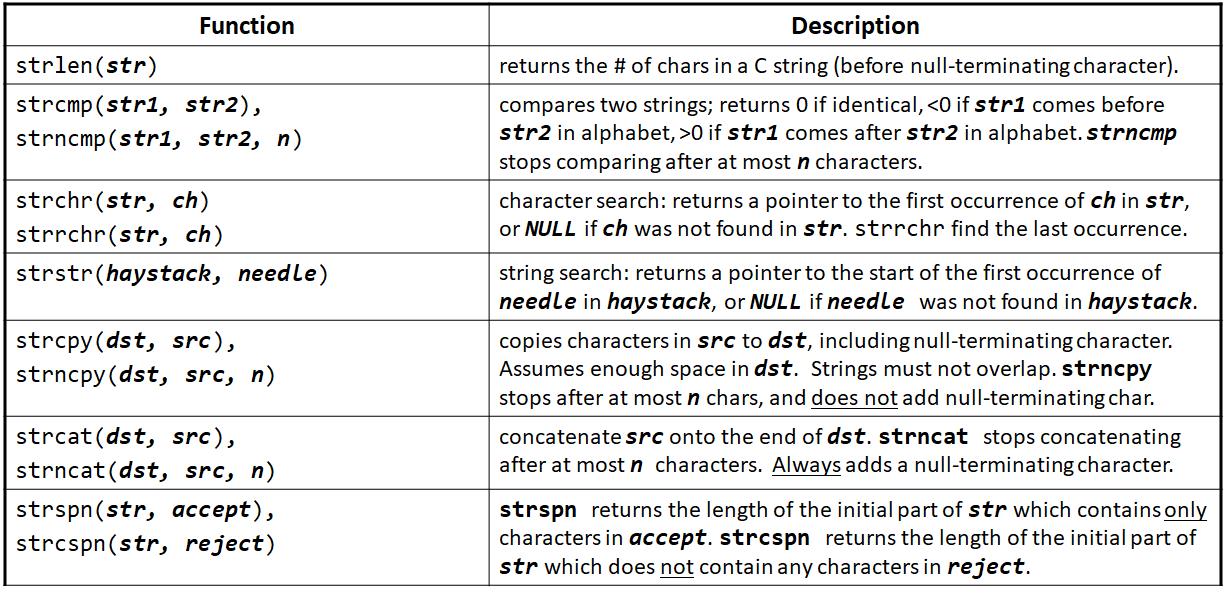string.h¶
本小节将以数组的观点来看待字符串!
标准库 string.h 提供了大量的字符串操作函数,但是这些函数大多不会作条件检查,所以输入参数必须是合法的字符串,在必要时也可以加一些条件判断。更多信息可以参考在线文档。

长度 strlen¶
和 C++ 中 std::string 不同的是,C 语言的字符串不是对象,不包含字符串相关的信息(例如字符串的长度)。
如果想计算一个字符串的长度,我们可以使用 strlen 标准函数,结尾终止字符不会统计在内。对于 “Hello” 字符串,计算结果如下:
#include <string.h>
char myString[] = {'H', 'e', 'l', 'l', 'o'};
int length = strlen(myString); // 5
辨析:数组长度 vs 字符串长度
sizeof 除了可以计算数据类型的长度,还可以用于计算数组的大小,语法类似于 sizeof(arr)/sizeof(arr[0])。
由于字符串会添加空白终止字符到末尾,所以不可以使用该语法替代 strlen。
注意 strlen 必须要遍历整个数组,所以其复杂度为 O(N)。
比较 strcmp¶
比较操作符,比如 ==,< 或 > 等,无法比较字符串。下面的写法,实际上是在比较字符串首字符的地址。
// e.g. str1 = 0x7f42, str2 = 0x654d
void doSomething(char str1[], char str2[]) {
if (str1 > str2) { // compares 0x7f42 > 0x654d!
// …
}
}
比较两个字符串可以使用 strcmp(str1, str2),该函数会依次比较字符数组中的每个字符,并返回一个整型。
两个字符串相等时,返回 0
str1中的字符比str2中的字符靠前,返回负值str1中的字符比str2中的字符靠后,返回正值
#include <string.h>
int compResult = strcmp(str1, str2);
if (compResult == 0) {
// equal
} else if (compResult < 0) {
// str1 comes before str2
} else {
// str1 comes after str2
}
复制 strcpy¶
赋值操作 = 并不能将一个字符串复制给另一个字符串变量。下面的写法,实际上是复制的时字符串首字符的地址。
// e.g. param1 = 0x7f42, param2 = 0x654d
void doSomething(char param1[], char param2[]) {
param1 = param2; // copies 0x654d. Points to same string!
param2[0] = 'H'; // modifies the one original string!
}
复制整体字符串可以使用 strcpy(dst, src)。该函数会将 src 字符数组复制到 dst 字符数组中,包括 '\0' 终止字符。注意该函数是有返回值的,返回 dst 字符串。
char str1[6];
strcpy(str1, "hello");
char str2[6];
strcpy(str2, str1);
str2[0] = 'c';
printf("%s", str1); // hello
printf("%s", str2); // cello
使用 strcpy 要特别注意,dst 数组大小一定不能小于 src 数组。如上所述,可以使用 sizeof 进行条件检查。
以下代码是可以正常复制的,数组的大小恰好可以容下字符串 "hello" 和一个终止符。
char str1[6];
strcpy(str1, "hello");
char str2[6];
strcpy(str2, str1);

但是接下来的代码就会有问题,str2 无法容下 "hello, world!",但是复制操作依然会进行,这样造成的后果是 str2 后面的字节将被覆盖。
char str1[14];
strcpy(str1, "hello, world!"); // correct
char str2[6];
strcpy(str2, str1); // not enough space - overwrites other memory!

如果 str2 后面的字节被系统中其他程序使用,那么覆盖写入将会造成严重的安全问题。我们将这种越界写入问题,称作缓冲区溢出(buffer overflow)。
复制 strncpy¶
复制部分字符串可以使用 strncpy(dst, src),与 strcpy 不同的是 strncpy 并不保证 dst 字符串以 '\0' 结尾。
// copying "hello"
char str2[5];
strncpy(str2, "hello, world!", 5); // doesn't copy '\0'!
补充:没有 ‘\0’ 终止符的字符数组
如果字符数组没有 '\0' 终止符,那么系统就无法确定字符串的结尾。例如,使用 strlen 计算该字符数组的长度时,函数将一直读取该字符数组随后的字节,直到发现终止字符为止。
由于没有终止字符,在调用 strlen 时,会一直计算到随后的系统其他部分的 '\0' 处。
char str2[5];
strncpy(str2, "hello, world!", 5); // doesn't copy '\0'!
int length = strlen(str2);

同样,由于没有终止字符,printf 也会一直打印到有 '\0' 的地方,输出的结果可能就会包含乱码:hello⍰⍰J⍰⍰⍰。
拼接 strcat strncat¶
同样,拼接字符串也不能直接使用 + 操作符。下面的写法,实际上是相加两个字符串首字符的地址。
// e.g. param1 = 0x7f, param2 = 0x65
void doSomething(char param1[], char param2[]) {
printf("%s", param1 + param2); // adds 0x7f and 0x65!
// ...
}
拼接两个字符串可以使用 strcat(str1, str2),拼接指定的几个字符可以使用 strncat(str1, str2)。这两个函数在拼接过程中,会去除原始字符串的终止字符,并能够保证返回的结果字符串以 '\0' 结尾。
以下示例创建了两个字符串,其中 str1 所在字符数组留有足够空间用于拼接字符串 str2。
char str1[13]; // enough space for strings + '\0'
strcpy(str1, "hello ");
char str2[7];
strcpy(str2, "world!");
strcat(str1, str2); // hello world!
函数 strcat 会去除 str1 中的终止字符,并紧随其后追加 str2 中的字符。

间距 strspn strcspn¶
strspn 计算字符串开头部分,只包含第二个参数中出现的字符的长度。
char bailey[11];
strcpy(bailey, "Bailey Dog");
int spanLength = strspn(bailey, "aBeoi");
printf("%d\n", spanLength); // 3
char bailey[11];
strcpy(bailey, "gailey Dog");
int spanLength = strspn(bailey, "aBeoi");
printf("%d\n", spanLength); // 0
strcspn 是 strspn 的互补函数,计算字符串开头部分,不包含第二个参数中出现的字符的长度。
char bailey[11];
strcpy(bailey, "Bailey Dog");
int spanLength = strcspn(bailey, "aBeoi");
printf("%d\n", spanLength); // 0
char bailey[11];
strcpy(bailey, "gailey Dog");
int spanLength = strcspn(bailey, "aBeoi");
printf("%d\n", spanLength); // 1
搜索 strchr strrchr strstr¶
strchr 搜索字符串中的字符,返回一个指向该字符的指针。
如果字符串中有多个相同的字符,则返回首个字符的指针;
如果字符串中没有该字符,则返回
NULL。
strrchr 区别于 strchr,如果字符串中有多个相同的字符,则返回最后一个字符的指针。
char myString[6];
strcpy(myString, "Hello");
char* charL = strchr(myString, 'l');
char* charL2 = strrchr(myString, 'l');
printf("%c\n", myString); // 'H'
printf("%c\n", charL); // 'l'
printf("%c\n", charL2); // 'l'
strstr 搜索字符串中的子字符串,并返回一个指向该字符串的指针。
如果字符串中有多个相同的子字符串,则返回首个子字符串的指针;
如果字符串中没有该子字符串,则返回
NULL。
char bailey[11];
strcpy(bailey, "Bailey Dog");
char* substr = strstr(bailey, "Dog");
printf("%s\n", bailey); // Bailey Dog
printf("%s\n", substr); // Dog
思考:此指针非彼指针
strchr/strrchr 和 strstr 都返回了一个 char*,但前者表示字符指针,后者却表示子字符串。系统是如何区分的?